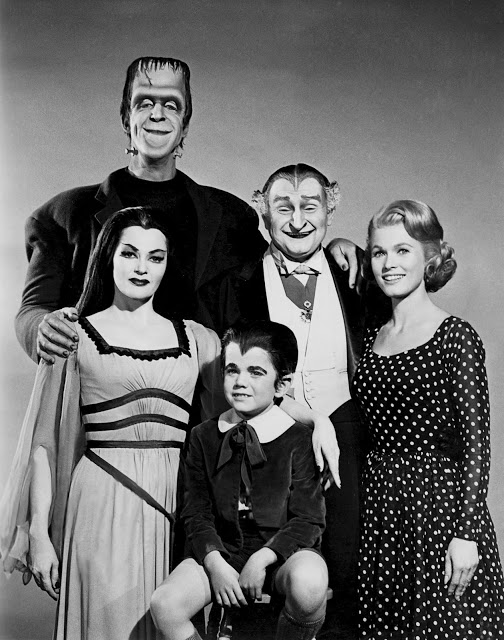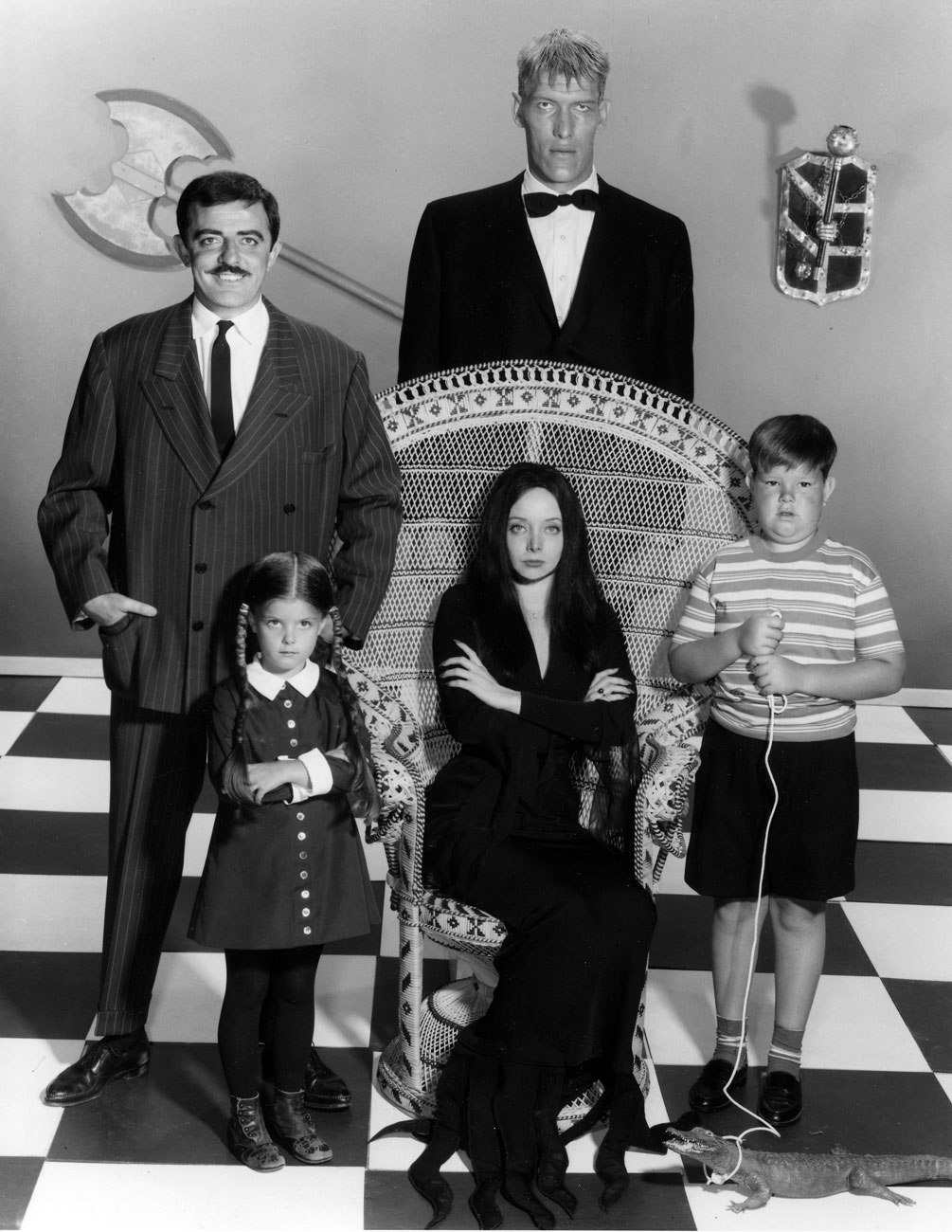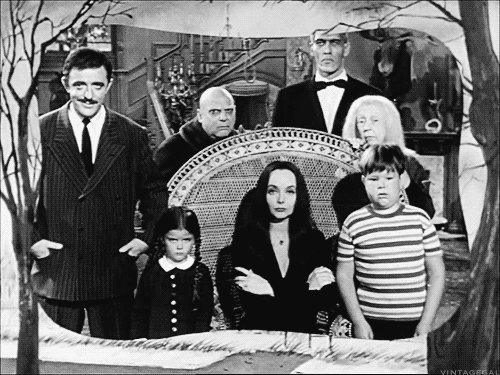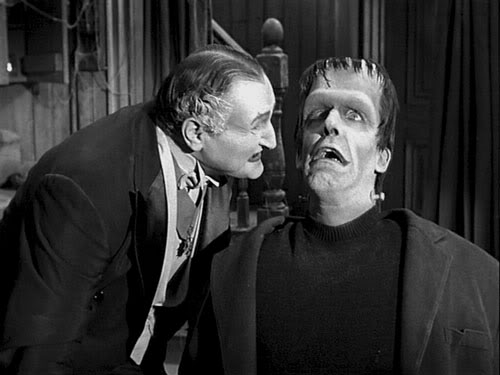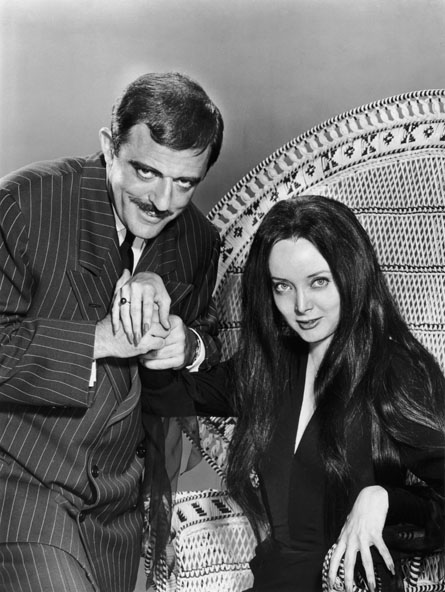Small-Screen 66 – #56: The Munsters [and The Addams Family]
(CBS, 1964-66 / ABC, 1964-66)
“Unlike life’s messy questions, the answers in trivia are always clear-cut…binary…you can’t be sure that you shouldn’t have accepted that job in Fresno, but you can be 100 percent sure that the Munsters lived at 1313 Mockingbird Lane.”
– Ken Jennings
For today’s offering, we have a pair of rival sitcoms. Both centered on families who were monstrous in their appearance and hobbies, yet treated one another with kindness and regarded themselves as “normal” folks. Both families dwelt in gothic mansions bedecked with the stereotypical “haunted house” trappings, and both kept fittingly “spooky” pets. The two shows even aired over the same two years.
And they both featured killer theme songs.
The Munsters follows the title family, each member of which resembles a classic movie monster (specifically, the iconic designs from the Universal monster flicks of the 30s and 40s). Lumbering patriarch Herman (Fred Gwynne) is modeled after Boris Karloff’s Frankenstein monster. Mother Lily (Yvonne De Carlo) is a vampire, though her black-and-white-streaked hair also calls to mind Universal’s “Bride of Frankenstein.” Their young son, Eddie (Butch Patrick), is a werewolf. And rounding out the family is “Grandpa” (Al Lewis), Lily’s father and another vampire. Don’t try to reason out the heredity of it all – to quote a clever jingle (set to the show’s theme tune) which ran on TV Land when the channel aired the program,
“Does it seem illogical, the way the Munsters family was formed? /
A vampire and a Frankenstein, giving birth to a little wolf-boy…
It seems that genetics don’t apply, to the Munsters!”
Admittedly, much of the series’ humor derives from a single joke: That the Munsters view their “monstrous” appearance and lifestyle as normal. Meanwhile, everyone else in their community performs cartoonishly exaggerated double-takes of terror upon simply SEEING a Munster (mirrors crack, flowers die, etc.). The family remains mostly oblivious to the fear they strike in others, or at least to the fact that they inspired it. If anything, the Munsters tend to look down on the people we think of as “normal” as ugly and out-of-touch. This includes Lily’s niece Marilyn, a statuesque young blonde, and the one non-monster Munster. The family regards Marilyn as hopelessly unattractive, speaking of her appearance in hushed tones, as a family embarrassment. But Marilyn is a Munster through and through, and shares her relatives’ ghoulish hobbies and world-view. When the many men she attracts inevitably run screaming from the house, she chalks it up to her “homeliness,” rather than the monstrous nature of her family.
The Addams Family was inspired by a series of single-panel cartoons by Charles Addams which appeared in the New Yorker beginning in 1938. The TV series, in addition to introducing the iconic “finger-snap” theme song, also marked the first time Addams’ characters were given names: Gomez, the father, whose hobbies include yoga and blowing up model trains; Morticia, the gaunt mother who skitters across the floor in a supernaturally tight dress, daughter Wednesday and son Pugsley (sunnier here than in later incarnations of the franchise); Gomez’s mother, “Grandmama” Addams; and Morticia’s Uncle Fester, an eccentric bald man with bulging eyes who was capable of illuminating lightbulbs clamped between his teeth. The Addamses are assisted around the house by a pair of appropriately macabre servants: Lurch, a towering, grumbling butler, and Thing, a disembodied hand (both Lurch and Thing were portrayed by 6’9” actor Ted Cassidy).
Despite sharing many common elements, the two shows are markedly different in some respects. So let’s apply our 3rd-and-4th grade English class skills and…COMPARE AND CONTRAST!
-In spite of their elegant home, the Munsters are primarily “blue collar.” For most of the series, breadwinner Herman works at a funeral parlor (the only place his cadaverous countenance doesn’t seem out of place). But many episodes deal with him trying his hand at other odd jobs, from singing sensation (you can’t see his face on the radio, after all) to professional sports (his superhuman strength never fails to wow talent scouts). The Addamses, on the other hand, could comfortably be termed “idle rich.” Rather than working steady jobs, they spend most of their time engaged in their quirky hobbies at home, and much of the show’s humor comes from the reactions of various visitors to the Addams abode. The theme song rings true: “Their house is a museum, where people come to see ‘em.” The Munsters’ more active lifestyle allows for a wider variety of plots than the homebound Addamses, keeping their series feeling a little fresher. Point goes to The Munsters.
-Individually speaking, the Addamses are probably more memorable (and unique) characters than the Munsters – the hulking Lurch and electrified Fester are certainly more instantly recognizable than the Universal-copycat designs of the Munster clan. Point goes to The Addams Family.
-And yet, when the two groups are considered in terms of ensemble chemistry, the debate becomes more nuanced. The father-/son-in-law relationship between mad scientist Grandpa and the bumbling Herman produces much of the Munsters’ non-doubletake humor. The Munsters reunited Fred Gwynne and Al Lewis, who had both appeared in Car 54, Where Are You? a sitcom about New York policemen which ran from 1961-63. Whether they’re bickering or collaborating (Grandpa often ropes Herman into serving as guinea pig for his many experiments), Gwynne and Lewis make for a consistently funny duo. On the Addams’ side of the scale, Gomez and Morticia share a romantic passion unmatched by anything Mockingbird Lane has to offer. Morticia need only speak a few words of French and Gomez is climbing the walls in amorous paroxysms. My Aunt and Uncle famously went to a Halloween party dressed as the spooky sweethearts…it does make a great couple’s costume. I’ll call “ensemble chemistry” a draw.
-Let’s be real for a moment: The Addams Family is undoubtedly the more iconic franchise. In addition to the 60s series, Charles Addams’ characters have been “resurrected” in two animated series and a pair of theatrically-released 90s films (as well a third, direct-to-video installment). They’ve inspired video games, a popular pinball machine, and a breakfast cereal. Heck, they even met Scooby-Doo. But you can’t keep a good Munster down, either: Herman et al appeared in a string of television movies (and one theatrical film, addressed in 2013’s “Creepy Classic Countdown”). A sequel series, The Munsters Today, ran for three entire seasons in the late-80s. And believe it or not, in 2012 NBC aired Mockingbird Lane, a failed pilot for a “re-imagining” of the series which was instead shown as a one-off Halloween special. True to their undead nature, the Munsters live on, even in relative obscurity. Point to the Addamses, kudos to the Munsters.
A few final points to consider:
-Pets: Thing is way cooler than the Munsters’ only half-seen dragon, “Spot.” Addams point.
-Cars: With not one but two unforgettable, funerary-themed cars designed by mechanic to the stars George Barris (who also built the 1960s Batmobile), the Munsters family drives in style. Munsters point.
-Theme Song: While the *click click* of the Addams Family finger-snaps will forever be seared in our cultural memory, I love the surf-rock electric guitar theme of The Munsters. It may be the one regard in which Munsters demonstrates a greater degree of originality than Addams. We’ll call this one a draw too.
If I counted right, that leaves The Addams Family one point ahead…but I’m going to call it for The Munsters all the same. Because this is my page, and I make the rules. The Munsters is the show I saw first, and the one I’ve watched more of. And while their ghoulish contemporaries, the Addamses, will likely always eclipse them in terms of popularity and acclaim, I’ll always have a soft spot in my heart for underdog undertaker Herman and his frightful family.
Tidbit: To those of you who have seen my horror-host program, Count Gauntly’s Horrors from the Public Domain — Yes, Lurch had more than a little influence on my conception of the “Ogrot” character.
—
You can keep up with Brian’s Small-Screen 66 countdown here.


